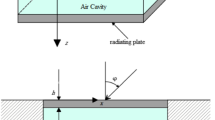Abstract
Vibro-acoustic sensitivity is used to predict the change of structure displacement and acoustic pressure when the design variable has been changed, which is significant for reducing the vibration and noise of systems. The sensitivity of structure displacement and acoustic pressure with respect to design variables are formulated based on the proposed 3D coupled vibro-acoustic system model. The dynamic variables within the entire solution domain are approximated in terms of global wave functions, which are exact solutions of the homogeneous parts of the control equations and the particular solutions, which are exact solutions of the inhomogeneous control equations, so no discretization is needed and the functions are regular. Based on a 3D vibro-acoustic cavity example model, the validation of the method is proven, and the sensitivity of structure displacement and acoustic pressure with respect to thickness of the plate and exciting frequency are obtained.
Similar content being viewed by others
References
Atalla N. and Bernhard R.J. (1994). Review of numerical solutions for low-frequency vibro-acoustic problems. Appl. Acoust. 43: 271–294
Bouillard I.F. (1999). Error estimation and adaptivity for the finite element method in acoustics: 2D and 3D applications. Comput. Meth. Appl. Mech. Eng. 176: 147–163
Kleiber M. (1993). Shape and non-shape structural sensitivity analysis for problems with any material and kinematic non-linearity. Comput. Meth. Appl. Mech. Eng. 108: 73–97
Banjeree P.K. and Butterfield R. (1981). Boundary Element Method in Engineering Science. McGraw-Hill, London
Barone M.R. and Yang R.J. (1989). A boundary element approach for recovery of shape sensitivities in three dimensional elastic solids. Comput. Meth. Appl. Mech. Eng 74: 69–82
Sarigul A.S. and Secgin A. (2004). A study on the applications of the acoustic design sensitivity analysis of the vibrating bodies. Appl. Acoust. 65: 1037–1065
Vanmaele, C., Desmet, W., Vandepitte, D.: On the use of the wave based method for the steady-state dynamic analysis of three-dimensional plate assemblies. In: Proceedings of ISMA2004, Leuven, Belgium, pp. 1002–1013 (2004)
Kita E., Kamiya N. and Ikeda Y. (1995). An application of Trefftz method to the sensitivity analysis of two-dimensional potential problem. Int. J. Numer. Methods. Eng. 38(13): 2209–2224
Kita E. and Ikeda Y. (2005). Sensitivity scheme of boundary value problem of 2D Poisson equation by using Trefftz method. Eng. Anal. Bound. Elem. 29: 738–748
Leissa A. (1993). Vibration of Plates. Acoustical Society of America, Woodbury
Author information
Authors and Affiliations
Corresponding author
Rights and permissions
About this article
Cite this article
He, X., Huang, Q. & You, C. A new sensitivity analysis scheme for coupled vibro-acoustic system using wave based method. Arch Appl Mech 79, 125–134 (2009). https://doi.org/10.1007/s00419-008-0219-4
Received:
Accepted:
Published:
Issue Date:
DOI: https://doi.org/10.1007/s00419-008-0219-4




